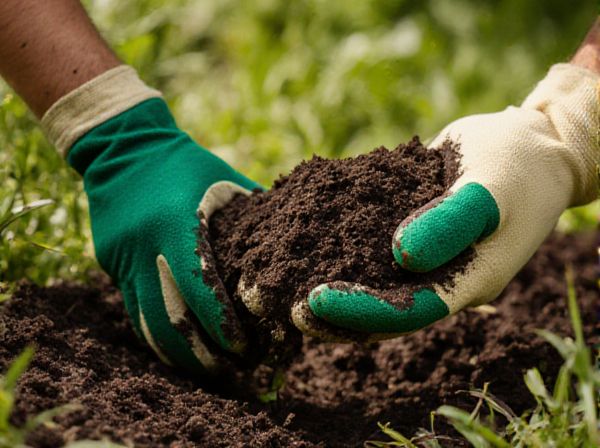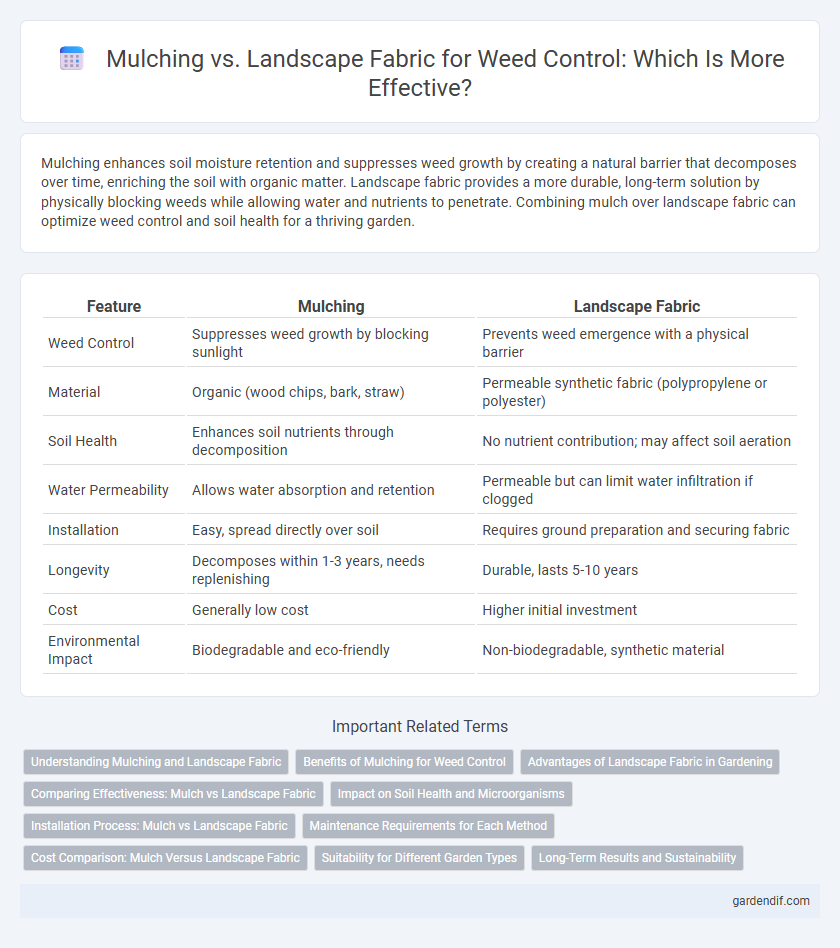
Mulching vs Landscape Fabric Illustration
Mulching enhances soil moisture retention and suppresses weed growth by creating a natural barrier that decomposes over time, enriching the soil with organic matter. Landscape fabric provides a more durable, long-term solution by physically blocking weeds while allowing water and nutrients to penetrate. Combining mulch over landscape fabric can optimize weed control and soil health for a thriving garden.
Table of Comparison
| Feature | Mulching | Landscape Fabric |
|---|---|---|
| Weed Control | Suppresses weed growth by blocking sunlight | Prevents weed emergence with a physical barrier |
| Material | Organic (wood chips, bark, straw) | Permeable synthetic fabric (polypropylene or polyester) |
| Soil Health | Enhances soil nutrients through decomposition | No nutrient contribution; may affect soil aeration |
| Water Permeability | Allows water absorption and retention | Permeable but can limit water infiltration if clogged |
| Installation | Easy, spread directly over soil | Requires ground preparation and securing fabric |
| Longevity | Decomposes within 1-3 years, needs replenishing | Durable, lasts 5-10 years |
| Cost | Generally low cost | Higher initial investment |
| Environmental Impact | Biodegradable and eco-friendly | Non-biodegradable, synthetic material |
Understanding Mulching and Landscape Fabric
Mulching involves applying organic materials such as wood chips, straw, or leaves to soil surfaces, enhancing moisture retention, temperature regulation, and weed suppression by blocking sunlight and creating a physical barrier. Landscape fabric, a woven or non-woven synthetic material, acts as a durable weed barrier by allowing water and air to pass through while preventing weed growth beneath it. Both methods improve garden health and weed control, but mulching adds organic matter and nutrients to the soil as it decomposes, whereas landscape fabric provides long-lasting physical weed prevention without enriching the soil.
Benefits of Mulching for Weed Control
Mulching provides effective weed control by creating a dense barrier that blocks sunlight, preventing weed seed germination and reducing competition for nutrients. Organic mulches such as wood chips and straw improve soil moisture retention and enhance soil health through decomposition, promoting a thriving environment for desired plants. Compared to landscape fabric, mulch is more environmentally friendly, easier to apply, and supports beneficial soil organisms that contribute to long-term weed suppression.
Advantages of Landscape Fabric in Gardening
Landscape fabric offers superior weed control by blocking sunlight, preventing weed germination and growth more effectively than mulching. It provides long-term durability and reduces the frequency of garden maintenance, saving time and effort. Additionally, landscape fabric allows water and nutrients to penetrate the soil while minimizing erosion and soil compaction, promoting healthier plant growth.
Comparing Effectiveness: Mulch vs Landscape Fabric
Mulching offers natural weed suppression by blocking sunlight and enriching soil moisture retention, promoting healthier plant growth. Landscape fabric provides a durable physical barrier that prevents weed penetration while allowing water and air flow, reducing soil erosion. Studies indicate mulch excels in organic nutrient delivery and soil improvement, whereas landscape fabric is more effective for long-term weed control in high-traffic garden areas.
Impact on Soil Health and Microorganisms
Mulching enhances soil health by retaining moisture, regulating temperature, and promoting beneficial microorganisms through organic matter decomposition. Landscape fabric, while effective at weed suppression, can hinder water infiltration and limit organic material incorporation, potentially disrupting microbial activity. Organic mulches support soil biodiversity and nutrient cycling, creating a healthier ecosystem compared to synthetic barrier effects of landscape fabric.
Installation Process: Mulch vs Landscape Fabric
Mulching involves spreading organic materials like wood chips or straw evenly over the soil surface, which is quick and requires minimal preparation. Landscape fabric installation demands a more detailed process, including soil leveling, cutting fabric to fit, securing with staples, and covering with mulch or gravel to ensure durability. Mulch installation is generally faster and more flexible, while landscape fabric offers long-term weed control but requires careful placement to avoid fabric degradation.
Maintenance Requirements for Each Method
Mulching requires periodic replenishment, usually every 1-2 years, and regular monitoring to prevent weed growth and maintain soil moisture. Landscape fabric offers longer-term weed control but may need occasional lifting to remove debris and prevent fabric degradation. Both methods reduce maintenance compared to bare soil, but fabric can complicate planting and requires careful installation to avoid gaps.
Cost Comparison: Mulch Versus Landscape Fabric
Mulching typically costs between $20 and $60 per cubic yard depending on the material, while landscape fabric installation can range from $100 to $300 for an average garden bed, factoring in fabric quality and labor. Mulch needs periodic replenishment every 1 to 2 years, which adds ongoing expenses, whereas landscape fabric offers a more durable solution with less frequent replacement. Choosing between mulch and landscape fabric depends on initial budget, long-term maintenance costs, and desired effectiveness in weed prevention.
Suitability for Different Garden Types
Mulching suits flower beds, vegetable gardens, and small-scale landscapes by enhancing soil moisture and organic content while suppressing weeds naturally. Landscape fabric is ideal for permanent installations like pathways, large shrub beds, and areas requiring strong weed barriers with minimal maintenance. Both methods vary in effectiveness depending on garden type, soil conditions, and long-term garden goals.
Long-Term Results and Sustainability
Mulching provides long-term weed suppression by decomposing organic matter that enriches soil health, promoting sustainable gardening practices. Landscape fabric offers immediate weed control but may degrade soil quality over time by restricting water and nutrient flow, leading to potential sustainability concerns. Choosing mulching over synthetic barriers supports an eco-friendly environment with improved soil fertility and moisture retention.
Mulching vs Landscape Fabric Infographic

 gardendif.com
gardendif.com